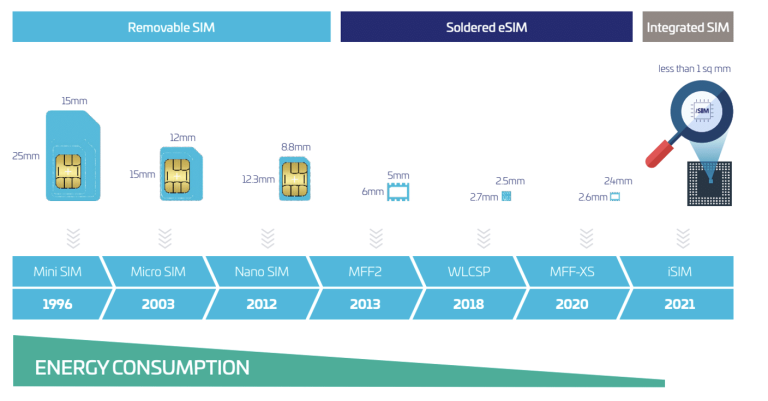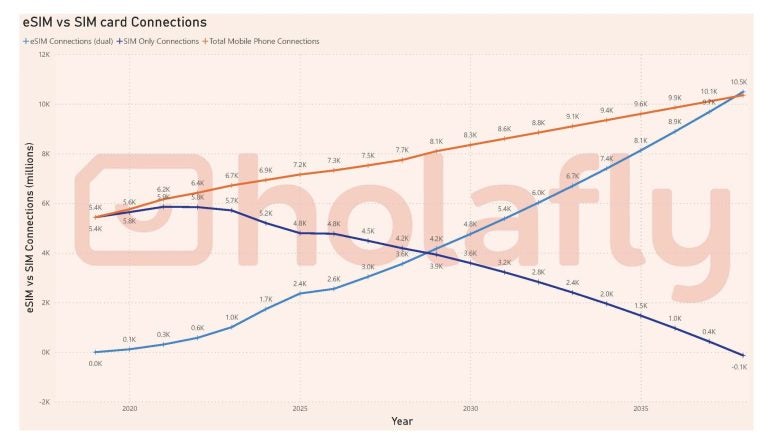When will the SIM card disappear?
With the rise of eSIMs, more phones are implementing the new tech. Little by little, the traditional SIM card is beginning to disappear.
The field of technology continues to be on the cutting edge of development in a world that is always shifting. The Subscriber Identity Module, or SIM card, is one innovation that has altered our methods of communication. These tiny chips have been used in mobile devices for decades to improve connectivity and provide easier access to information. Nonetheless, the question arises: When will the SIM card disappear? Given the rapid technological advances and the unrelenting march towards a hyper-connected future.
An Overview of the Development of Connectivity
Let’s take a quick trip through the evolution of the SIM card before getting into the card’s possible doom. The introduction of the SIM card in the early 1990s was a watershed moment in the history of the mobile industry. When inserted into a phone, this tiny card stores crucial subscriber information and establishes a connection to the appropriate network.
Micro SIM cards, nano SIM cards, and embedded SIM cards have all replaced standard SIM cards. In particular, the eSIM has been a precursor to a time when SIM cards will be obsolete. It gives its consumers the freedom and convenience of switching carriers remotely without having to physically swap out their cards. The SIM card, however, is still a physical component of our smartphones despite these advances.
The image below depicts the evolution of communication chips throughout time. Ever since 1991, the SIM card has been getting smaller. All this to save space, consume less energy, and even have a higher storage capacity. Currently, the iSIM is in the development stages, with pioneers opening up avenues for its future implementation. Sony has a short article where they explain how the iSIM is shaping the future of interconnectivity in the IoT. Take a more in-depth look at the differences between the eSIM and the iSIM.

A brief view of the SIM card
The Subscriber Identity Module has been around since the early 1990s, when it was launched as a way to authenticate mobile phone users on the go. Engineers at German smart card maker Giesecke & Devrient came up with the idea and in 1991, the European Telecommunications Standards Institute (ETSI) standardized the original subscriber identity module (SIM) card, also known as the “GSM SIM”. This facilitated the rollout of GSM (Global System for Mobile Communications) technology.
To safely store user data and cryptographic keys, these early SIM cards, about the size of a credit card, included a microprocessor chip with memory. Mini-SIM, micro-SIM, and nano-SIM cards were all introduced throughout the years to fit into increasingly compact mobile devices, as shown in the graphic above. The SIM chip is still an integral part of modern mobile communications, but it is slowly being put side by side with the digital SIM, and will most likely slowly phase out as more and more manufacturers turn to eSIM only smartphone models.
Since the birth of the SIM chip, the number of cellphone subscriptions has grown into the millions. It is estimated that there are more SIM cards in the world than people! There are more than 16.8 billion mobiles phones in the world and only 8.1 billion people. That’s more than two times over.

An Insight into the Future of eSIM
The widespread implementation of eSIM technology has paved the way for the conventional SIM card to disappear. Ever since its birth in 2012, the eSIM has been slowly but surely taking over the market. It’s come to the point where some manufacturers are developing phones without a SIM slot. The eSIM completely does away with the necessity for a SIM card. Instead, users’ subscriber information is saved digitally within the device’s hardware, facilitating digital activation and carrier switching. Many smartphones and wearable devices now support eSIM technology, and this trend is expected to continue.
The eSIM’s success can be attributed in large part to the superior user experience it provides. For example, tourists don’t need to swap SIM cards if they want to switch to a local carrier while they’re away. With eSIM, it’s much easier to connect and manage numerous IoT (Internet of Things) devices via a single network. Ramírez provides an insight into the importance of eSIMs in new technologies in his 2021 paper.
Did you know that being a leading country in technology, eSIM for Vietnam were among the first to be established. Today it is possible to find eSIM services in remote locations such as Tanzania and beyond. Holafly eSIM for Tanzania is an example of a provider in these areas.
In addition, people can now even purchase monthly eSIM subscription plans, ideal for frequent travelers. Holafly Connect is the perfect example, where people can even get unlimited data and unlimited hotspot for one monthly price, very similar to a physical SIM card.
Beyond 5G: Catalysts for Transformation
The need for better connectivity and more consistent experiences will only grow as we enter the 5G era and beyond. The promise of 5G networks is their ability to serve a huge number of devices at once without sacrificing speed or latency. The standard SIM card can be a hindrance in this setting, which is why its trend is to disappear.
For 5G-enabled devices to make the most of the network, they will need to seamlessly move between networks. To solve this problem, eSIM technology was developed. Its adaptability and remote provisioning make it a promising choice for handling the intricate needs of 5G networks. There may be less need for actual SIM cards as time goes on and technology develops.
Comparison: SIM, eSIM and iSIM
Here’s a chart comparing the characteristics of traditional SIM cards, eSIMs, and iSIMs:
| Aspect | Traditional SIM Card | eSIM | iSIM |
|---|---|---|---|
| Physical Form | Physical, removable card | Embedded chip SIM | Integrated into device hardware |
| Space Efficiency | Requires space for SIM card slot | More space-efficient than physical SIM | Most space-efficient, ideal for smaller devices |
| Remote Management | Not possible without physically changing cards | Remotely provisioned and managed | Remotely provisioned and managed |
| Switching Carriers | Requires changing physical card | Can switch carriers remotely without new card | Can switch carriers remotely without new card |
| Security | Less susceptible to remote hacking | Secure provisioning and encryption | Potential for enhanced security due to integration |
| IoT Applications | Limited due to physical card constraints | Suitable for IoT devices, streamlined management | Highly suitable for IoT devices and space-efficient |
| Standardization | Standardized globally | Standardization efforts are ongoing | Emerging technology, standardization in progress |
| Flexibility | Limited flexibility due to physical nature | More flexibility due to remote provisioning | High flexibility due to integration and remote management |
| Device Size | Can limit size and design options | Offers design flexibility in size-constrained devices | Offers maximum design flexibility |
| Adoption Stage | Mature technology | Growing adoption and gaining popularity | Emerging technology, early adoption in certain sectors |
| Challenges | Manual card replacement, physical limitations | Standardization, security, and compatibility | Standardization, security, and integration challenges |
Benefits of the SIM
Even though we know the SIM card is phasing out, we know that it was essential at one time and still is in many places. Let’s give it its due credit and take a look at pros and cons.
Advantages:
- Portability: nano-SIM cards are small and easily transferable between devices.
- Security: SIM cards store encryption keys and user data securely, making it difficult for unauthorized users to access the network or personal information.
- International Roaming: SIM cards facilitate international travel by allowing users to connect locally.
- Easy Activation: SIM cards are generally easy to activate, either automatically or manually.
Disadvantages
- Physical Vulnerability: The small size of SIM cards makes them susceptible to loss or damage. If lost or stolen, it can be used by unauthorized individuals. This can potentially lead to unauthorized charges and privacy concerns.
- Compatibility: Different devices may require different types of SIM cards (nano-SIM, micro-SIM, etc.). This can be inconvenient when switching between devices.
- Limited Storage: Storage capacity may become a limitation when storing numerous contacts or messages.
- Dependence on Carriers: SIM cards tie users to specific mobile carriers, making it difficult to switch carriers without obtaining a new SIM card.
Issues and Things to Think About
Despite the encouraging trends toward a SIM-less future, there are still certain obstacles and things to think about. Perhaps the most important issues are those of security and confidentiality. In terms of privacy, physical SIM cards have an advantage over their digital counterparts, eSIMs. It’s important to adequately address the legitimate worries that the possibility of hacking or unauthorized access to eSIMs has raised.
The shift to eSIMs also necessitates coordination between hardware vendors, cellular service providers, and government agencies. Smooth and consistent user experiences across devices and networks require the establishment of interoperability and defined standards. Logistical difficulties also arise in the process of converting existing customers to eSIMs.
Indications of change
Clearly, we can state that the SIM card won’t disappear overnight. However, we can smell the air. As we know, the eSIM iPhone 14, was the first phone to completely ditch the SIM card tray. And now, it’s being said that the rumored iPhone 15 won’t have it either. This doesn’t come as a shock, but it’s an indication that most likely Apple won’t launch any more iPhones with SIM card capabilities. Additionally, as we’ve seen in the past, other manufacturers will likely follow suit.
Finally, the verdict on when SIM cards will become obsolete.
Estimating when the SIM card will completely disappear is a difficult task. If current trends continue, however, it seems safe to say that the classic physical SIM card’s time has come and gone. The widespread adoption and increasing maturity of eSIM technology may eventually make it the de facto norm for establishing connections to mobile networks.
One Wall Street Journal article, published in 2022, gives a clearer view. “Physical SIMs won’t disappear immediately, but once Apple stops supporting them in its new iPhones, the writing is on the wall.”
Likely, it will be several years before physical SIM cards are no longer needed. For this to happen, we need to make strides in both technology and industry cooperation, as well as in regulatory reform and customer confidence in eSIM safety. However, the trajectory is unmistakable: we are headed toward a day when the idea of physically inserting a card into a device to gain access to a network will be relegated to the trash can of history.
Calculating from Research and Statistics
Generally, experts and opinions are divergent, but we have decided to do our own research and use statistics. With information and reports from Statista and GSMA Intelligence, that have been published recently, we have generated a chart calculating future trends based on current statistics and findings. If the current adoption of the digital SIM continues steadily, it’s projected that the physical SIM card will no longer be used or in popular use in 15 years. This may sound like a long time, however, most likely, it will be sooner.
Once profits from producing and commercializing plastic SIMs are no longer viable, manufacturers and operators will drop them completely. At that specific, SIM card connections will drop at a higher rate.

Not so Eco-Friendly SIM
The SIM card, even though for long has been our door to communication, also has a dark side. The process of producing, using and disposing of a SIM chip also takes its toll. In terms of CO2 emissions, the SIM card emits more than 229g CO2 eq. We found out that even since the SIM card was launched in the 1990s, more than 4.5 billion SIM cards have been distributed. This translates to the production of more than 540,000 tons of carbon dioxide and more than 18,000 tons of plastic waste each year! This plastic ends up in landfills and in the ocean. On the other hand, eSIMs don’t have this disadvantage. They only produce about 124g of CO2 eq. and it’s mainly only during their utilization stage of life.
Taking the Future by the Hand
In conclusion, the history of the SIM card’s development captures the dynamic nature of the technological and communications worlds. The standard SIM card was a game-changer when it was introduced. Now we’re headed toward a SIM-less future thanks to eSIMs and the impending 5G revolution. We must face the difficulties, guarantee safety, and collaborate to make the changeover as painless as possible.
The SIM card’s demise is more than just a shift in how we communicate. It’s emblematic of progress’s inexorable forward momentum. To make the most of this new era of connectedness, it will be necessary, as with any technological revolution, to accept change and adjust accordingly.





 Language
Language 


















 No results found
No results found





